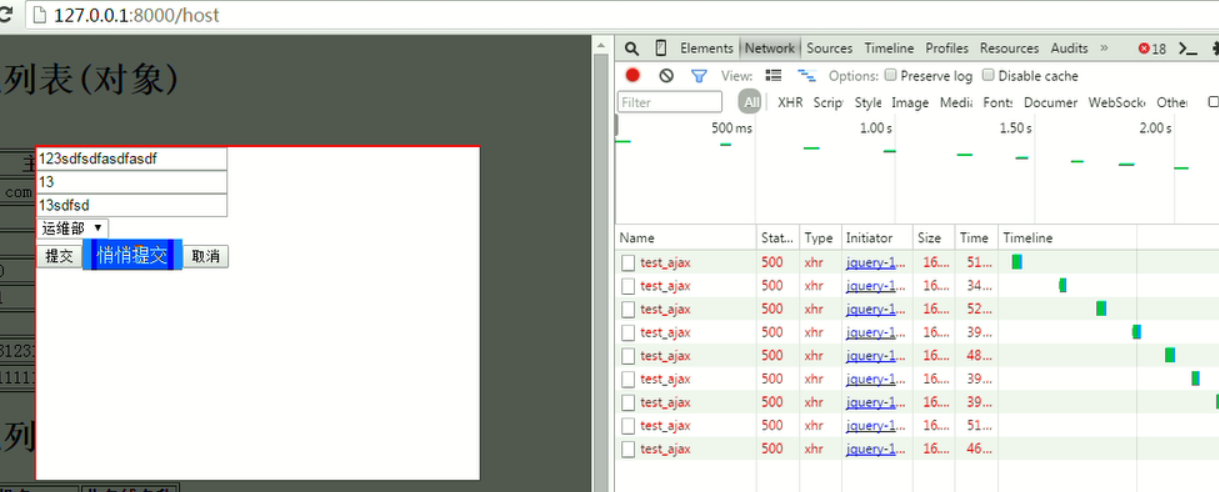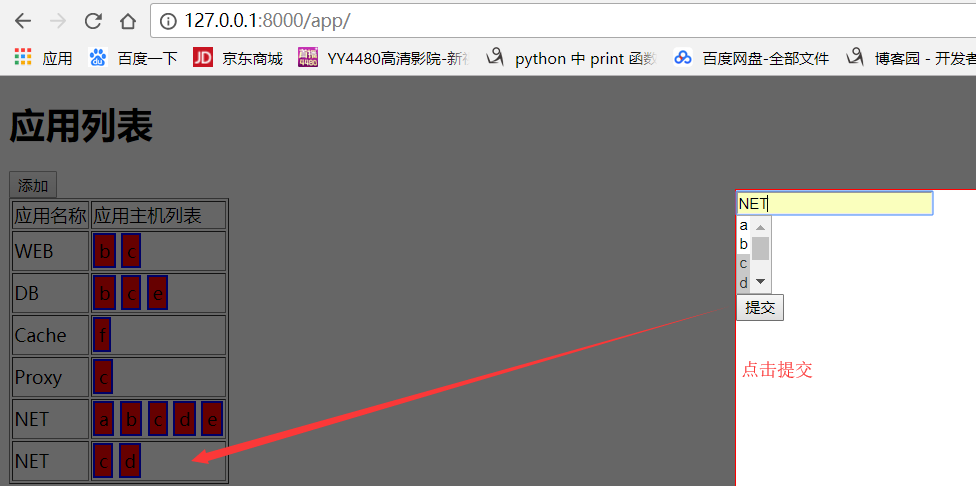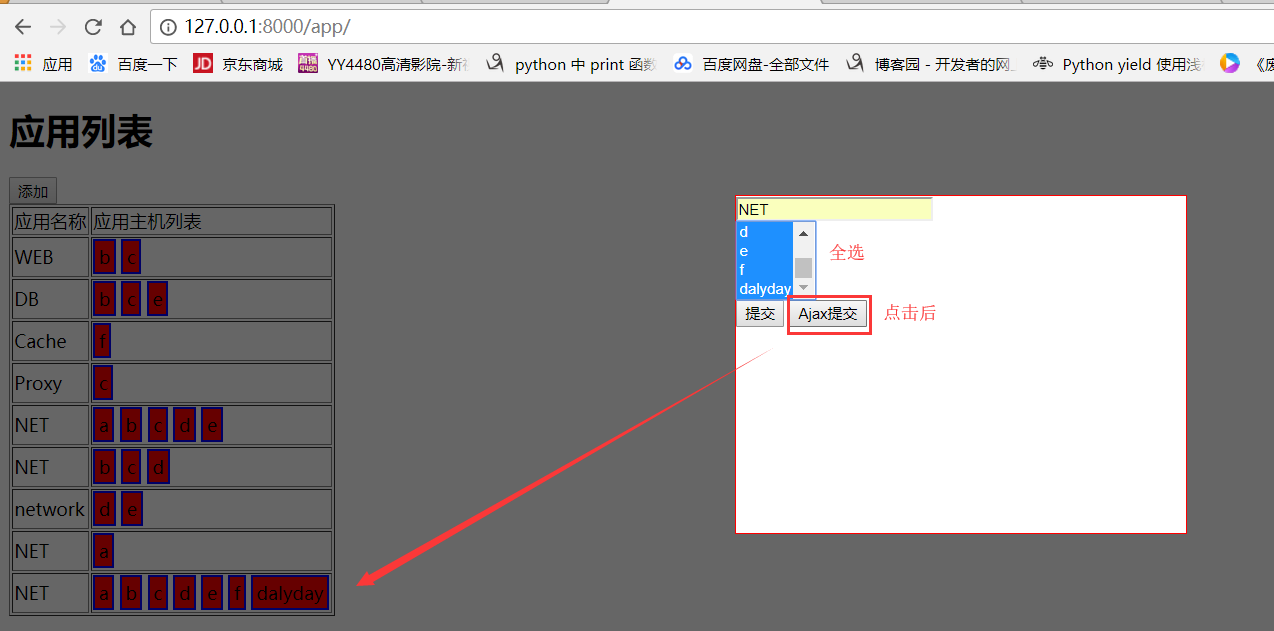【Django】ajax(多对多表单)
1.前后端交互
<div class="shade hide"></div> <!--遮罩层,全屏-->
<div class="add-modal hide"> <!--弹出框-->
<form method="POST" action="/host/"> <!--编辑弹出框内容-->
<div class="group">
<input id="host" type="text" placeholder="主机名" name="hostname"/>
</div> <div class="group">
<input id="ip" type="text" placeholder="IP" name="ip"/>
</div> <div class="group">
<input id="port" type="text" placeholder="端口" name="port"/>
</div> <div class="group">
<select id="sel" name="b_id">
{% for op in b_list %}
<option value="{{ op.id }}">{{ op.caption }}</option>
{% endfor %}
</select>
</div> <input type="submit" value="提交"/>
<a id="ajax_submit" style="display: inline-block;padding:5px;background: blue;color: white">悄悄提交</a>
<input id="cancel" type="button" value="取消"/>
</form>
</div>
templates/host.htmi #模版代码
$(function(){
$('#ajax_submit').click(function () {
$.ajax({
url:"/test_ajax/", //提交到
type:"POST", //什么方式提交
data:{'hostname':$('#host').val(),'ip':$('#ip').val(),'port':$('#port').val(),'b_id':$('#sel').val()}, //提交什么数据
success:function (data) {
if(data=='OK'){
location.reload() // 重新加载页面
}else {
alert(data);
}
}
})
})
})
#Ajax代码
templates/host.html #ajax代码
def test_ajax(requset):
h = requset.POST.get('hostname')
i = requset.POST.get('ip')
p = requset.POST.get('port')
b = requset.POST.get('b_id')
if h and len(h) > 5: #
models.Host.objects.create(hostname=h,
ip=i,
port=p,
b_id=b,)
return HttpResponse('OK')
else:
return HttpResponse('开不了门')
app01/views
<!DOCTYPE html>
<html lang="en">
<head>
<meta charset="UTF-8">
<title>Title</title>
<style>
.hide{
display: none;
}
.shade{
position: fixed;
top: 0;
right:0 ;
left: 0;
bottom: 0;
background: black;
opacity: 0.6;
z-index: 100;
}
.add-modal{
position: fixed;
height: 300px;
width: 400px;
top: 100px;
left: 50%;
z-index: 101;
border: 1px solid red;
background: white;
margin-left: -200px;
}
</style>
</head>
<body>
<h1>主机列表(列表)</h1>
<div>
<input id="add_host" type="button" value="添加"/> <!--模态对话框-->
</div>
<table border=""> <thead>
<tr>
<th>主机序号</th>
<th>主机名字</th>
<th>IP</th>
<th>端口</th>
<th>业务线名称</th>
</tr>
</thead>
<tbody>
{% for row in v1 %}
<tr aa="{{ row.nid }}" ab="{{ row.b.id }}" ac="{{ row.b.code }}">
<td>{{ forloop.counter }}</td>
<td>{{ row.hostname }}</td>
<td>{{ row.ip }}</td>
<td>{{ row.port }}</td>
<td>{{ row.b.caption }}</td>
</tr>
{% endfor %}
</tbody>
</table>
<h1>主机列表(字典)</h1>
<table border="">
<thead>
<tr>
<th>主机名字</th>
<th>业务线名称</th>
</tr>
</thead>
<tbody>
{% for row in v2 %}
<tr aa="{{ row.nid }}" ab="{{ row.b__id }}">
<td>{{ row.hostname }}</td>
<td>{{ row.b__caption }}</td>
</tr>
{% endfor %}
</tbody>
</table>
</table>
<h1>主机列表(元组)</h1>
<table border="">
<thead>
<tr>
<th>主机名字</th>
<th>业务线名称</th>
</tr>
</thead>
<tbody>
{% for row in v3 %}
<tr aa="{{ row.0 }}" ab="{{ row.2}}">
<td>{{ row.1 }}</td>
<td>{{ row.3 }}</td>
</tr>
{% endfor %}
</tbody>
</table> <div class="shade hide"></div> <!--遮罩层,全屏-->
<div class="add-modal hide"> <!--弹出框-->
<form method="POST" action="/host/"> <!--编辑弹出框内容-->
<div class="group">
<input id="host" type="text" placeholder="主机名" name="hostname"/>
</div> <div class="group">
<input id="ip" type="text" placeholder="IP" name="ip"/>
</div> <div class="group">
<input id="port" type="text" placeholder="端口" name="port"/>
</div> <div class="group">
<select id="sel" name="b_id">
{% for op in b_list %}
<option value="{{ op.id }}">{{ op.caption }}</option>
{% endfor %}
</select>
</div> <input type="submit" value="提交"/>
<a id="ajax_submit" style="display: inline-block;padding:5px;background: blue;color: white">悄悄提交</a>
<input id="cancel" type="button" value="取消"/>
</form>
</div> <script src="/static/jquery-1.12.4.js"></script> <!--JS文件-->
<script>
$(function () { <!--页面框架加载完成--> $('#add_host').click(function () { <!--绑定事件-->
$('.shade,.add-modal').removeClass('hide'); <!--点击添加按钮,呼出遮罩层与弹出框-->
}); $('#cancel').click(function () {
$('.shade,.add-modal').addClass('hide');
}); $('#ajax_submit').click(function () {
$.ajax({
url:"/test_ajax/", <!--提交到-->
type:'POST', <!--什么方式提交-->
data:{'hostname':$('#host').val(),'ip':$('#ip').val(),'port':$('#port').val(),'b_id':$('#sel').val()}, <!--提交什么数据-->
success:function (data) {
if (data == 'OK'){
location.reload() <!--重新加载页面-->
}else {
alert(data);
}
}
})
}) })
</script>
</body>
</html>
templates/host.html总代码
2.后端发送请求,前端无法感受,且页面无反应

<form method="POST" action="/host/"> <!--编辑弹出框内容-->
<div class="group">
<input id="host" type="text" placeholder="主机名" name="hostname"/>
</div> <div class="group">
<input id="ip" type="text" placeholder="IP" name="ip"/>
</div> <div class="group">
<input id="port" type="text" placeholder="端口" name="port"/>
</div> <div class="group">
<select id="sel" name="b_id">
{% for op in b_list %}
<option value="{{ op.id }}">{{ op.caption }}</option>
{% endfor %}
</select>
</div> <input type="submit" value="提交"/>
<a id="ajax_submit" style="display: inline-block;padding:5px;background: blue;color: white">悄悄提交</a>
<input id="cancel" type="button" value="取消"/>
<span id="error_msg" style="color:red"></span>
</form>
templates/host.htmi #模版代码
$(function () {
$('#ajax_submit').click(function () {
$.ajax({
url:"/test_ajax/", <!--提交到-->
type:'POST', <!--什么方式提交-->
data:{'hostname':$('#host').val(),'ip':$('#ip').val(),'port':$('#port').val(),'b_id':$('#sel').val()}, <!--提交什么数据-->
success:function (data) {
var obj = JSON.parse(data); //反序列,字符串转换成对象
if(obj.status){
location.reload();
}else {
$('#error_msg').text(obj.error);
}
}
})
})
})
templates/host.html #ajax代码
def test_ajax(requset):
import json
ret = {'status':True,'error':None,'data':None}
try:
h = requset.POST.get('hostname')
i = requset.POST.get('ip')
p = requset.POST.get('port')
b = requset.POST.get('b_id')
if h and len(h) > 5: #
models.Host.objects.create(hostname=h,
ip=i,
port=p,
b_id=b, )
else:
ret['status'] = False
ret['error'] ='太短了'
except Exception as e:
ret['status'] = False
ret['error'] = '请求错误'
return HttpResponse(json.dumps(ret)) #字符串,形似字典
app01/views
3.利用serialize自动获取form表单数据
<div class="edit-modal hide"> <!--弹出框-->
<form id="edit_form" method="POST" action="/host/"> <!--编辑弹出框内容-->
<input type="text" name="aa" style="display: none" />
<input id="host" type="text" placeholder="主机名" name="hostname"/>
<input id="ip" type="text" placeholder="IP" name="ip"/>
<input id="port" type="text" placeholder="端口" name="port"/>
<select id="sel" name="b_id">
{% for op in b_list %}
<option value="{{ op.id }}">{{ op.caption }}</option>
{% endfor %}
</select>
<a id="ajax_submit_edit">确认编辑</a>
</form>
</div>
templates/host #模版代码
$(function () {
$('.edit').click(function () {
$('.hide,.edit-modal').removeClass('hide');
var ab = $(this).parent().parent().attr('ab');
var aa = $(this).parent().parent().attr('aa');
$('#edit_form').find('select').val(ab);
$('#edit_form').find('input[name="aa"]').val(aa);
//修改
$.ajax({
//data:{'hostname':$('#host').val(),'ip':$('#ip').val(),'port':$('#port').val(),'b_id':$('#sel').val()},
data:$('#edit_form').serialize() //取代上面一句话,通过form中的id="edit_form"值一一对应发到后台(name是name,值是值)
})
}
templates/host.html #ajax代码
<!DOCTYPE html>
<html lang="en">
<head>
<meta charset="UTF-8">
<title>Title</title>
<style>
.hide{
display: none;
}
.shade{
position: fixed;
top: 0;
right:0 ;
left: 0;
bottom: 0;
background: black;
opacity: 0.6;
z-index: 100;
}
.add-modal,.edit-modal{
position: fixed;
height: 300px;
width: 400px;
top: 100px;
left: 50%;
z-index: 101;
border: 1px solid red;
background: white;
margin-left: -200px;
}
</style>
</head>
<body>
<h1>主机列表(列表)</h1>
<div>
<input id="add_host" type="button" value="添加"/> <!--模态对话框-->
</div>
<table border=""> <thead>
<tr>
<th>主机序号</th>
<th>主机名字</th>
<th>IP</th>
<th>端口</th>
<th>业务线名称</th>
<th>操作</th>
</tr>
</thead>
<tbody>
{% for row in v1 %}
<tr aa="{{ row.nid }}" ab="{{ row.b.id }}" ac="{{ row.b.code }}">
<td>{{ forloop.counter }}</td>
<td>{{ row.hostname }}</td>
<td>{{ row.ip }}</td>
<td>{{ row.port }}</td>
<td>{{ row.b.caption }}</td>
<td>
<a class="edit">编辑</a>|<a class="delete">删除</a>
</td>
</tr>
{% endfor %}
</tbody>
</table>
<h1>主机列表(字典)</h1>
<table border="">
<thead>
<tr>
<th>主机名字</th>
<th>业务线名称</th>
</tr>
</thead>
<tbody>
{% for row in v2 %}
<tr aa="{{ row.nid }}" ab="{{ row.b__id }}">
<td>{{ row.hostname }}</td>
<td>{{ row.b__caption }}</td>
</tr>
{% endfor %}
</tbody>
</table>
</table>
<h1>主机列表(元组)</h1>
<table border="">
<thead>
<tr>
<th>主机名字</th>
<th>业务线名称</th>
</tr>
</thead>
<tbody>
{% for row in v3 %}
<tr aa="{{ row.0 }}" ab="{{ row.2}}">
<td>{{ row.1 }}</td>
<td>{{ row.3 }}</td>
</tr>
{% endfor %}
</tbody>
</table> <div class="shade hide"></div> <!--遮罩层,全屏-->
<div class="add-modal hide"> <!--弹出框-->
<form method="POST" action="/host/"> <!--编辑弹出框内容-->
<div class="group">
<input id="host" type="text" placeholder="主机名" name="hostname"/>
</div> <div class="group">
<input id="ip" type="text" placeholder="IP" name="ip"/>
</div> <div class="group">
<input id="port" type="text" placeholder="端口" name="port"/>
</div> <div class="group">
<select id="sel" name="b_id">
{% for op in b_list %}
<option value="{{ op.id }}">{{ op.caption }}</option>
{% endfor %}
</select>
</div> <input type="submit" value="提交"/>
<a id="ajax_submit" style="display: inline-block;padding:5px;background: blue;color: white">悄悄提交</a>
<input id="cancel" type="button" value="取消"/>
<span id="error_msg" style="color:red"></span>
</form>
</div> <div class="edit-modal hide"> <!--弹出框-->
<form id="edit_form" method="POST" action="/host/"> <!--编辑弹出框内容-->
<input type="text" name="aa" style="display: none" />
<input id="host" type="text" placeholder="主机名" name="hostname"/>
<input id="ip" type="text" placeholder="IP" name="ip"/>
<input id="port" type="text" placeholder="端口" name="port"/>
<select id="sel" name="b_id">
{% for op in b_list %}
<option value="{{ op.id }}">{{ op.caption }}</option>
{% endfor %}
</select>
<a id="ajax_submit_edit">确认编辑</a>
</form> </div>
<script src="/static/jquery-1.12.4.js"></script> <!--JS文件-->
<script>
$(function () { <!--页面框架加载完成--> $('#add_host').click(function () { <!--绑定事件-->
$('.shade,.add-modal').removeClass('hide'); <!--点击添加按钮,呼出遮罩层与弹出框-->
}); $('#cancel').click(function () {
$('.shade,.add-modal').addClass('hide');
}); $('#ajax_submit').click(function () {
$.ajax({
url:"/test_ajax/", <!--提交到-->
type:'POST', <!--什么方式提交-->
data:{'hostname':$('#host').val(),'ip':$('#ip').val(),'port':$('#port').val(),'b_id':$('#sel').val()}, <!--提交什么数据-->
success:function (data) {
var obj = JSON.parse(data); //反序列,字符串转换成对象
if(obj.status){
location.reload();
}else {
$('#error_msg').text(obj.error);
}
}
})
}) $('.edit').click(function () {
$('.hide,.edit-modal').removeClass('hide'); var ab = $(this).parent().parent().attr('ab');
var aa = $(this).parent().parent().attr('aa'); $('#edit_form').find('select').val(ab);
$('#edit_form').find('input[name="aa"]').val(aa); //修改
$.ajax({
//data:{'hostname':$('#host').val(),'ip':$('#ip').val(),'port':$('#port').val(),'b_id':$('#sel').val()},
data:$('#edit_form').serialize() //取代上面一句话,通过form中的id="edit_form"值一一对应发到后台(name是name,值是值)
})
//更新
//models.host.objects.filter(nid=nid).update()
})
})
</script>
</body>
</html>
templates/host.html #总代码

4.多对多表单操作
class Host(models.Model):
nid = models.AutoField(primary_key=True)
hostname = models.CharField(max_length=64,db_index=True)
ip = models.GenericIPAddressField(protocol='ipv4',db_index=True)
port = models.IntegerField()
b = models.ForeignKey(to='Business',to_field='id') #创建多对多
# 方法一:(自定义关系表)
# class HosttoApp(models.Model):
# hobj = models.ForeignKey(to="Host",to_field='nid')
# aobj = models.ForeignKey(to="App",to_field="id") class App(models.Model):
name = models.CharField(max_length=32)
# 方法二:(自动创建关系表)
r = models.ManyToManyField("Host")
app01/models(方法二创建)
def app(request):
app_list = models.App.objects.all()
for row in app_list:
print(row.name,row.r.all())
return render(request,'app.html',{'app_list':app_list})
app01/views
<!DOCTYPE html>
<html lang="en">
<head>
<meta charset="UTF-8">
<title>Title</title>
<style>
.host_tag{
display:inline-block ;
padding: 3px;
border: 2px solid blue;
background-color: red;
}
</style>
</head>
<body> <h1>应用列表</h1> <table border="">
<thead>
<tr>
<td>应用名称</td>
<td>应用主机列表</td>
</tr>
</thead>
<tbody>
{% for app in app_list %}
<tr>
<td>{{ app.name }}</td>
<td>
{% for abc in app.r.all %}
<span class="host_tag">{{ abc.hostname }}</span>
{% endfor %}
</td>
</tr>
{% endfor %}
</tbody>
</table>
</body>
</html>
templates/app.html

4.1 多对多 app.html通过form刷新增加表单数据
<div class="shade hide"></div> <!--遮罩层,全屏-->
<div class="add-modal hide"> <!--弹出框-->
<form id="add_form" method="POST" action="/app/"> <!--编辑弹出框内容-->
<div class="group">
<input id="app_name" type="text" placeholder="应用名称" name="app_name"/>
</div> <div class="group">
<select id="host_list" name="host_list" multiple>
{% for op in host_list %}
<option value="{{ op.nid }}">{{ op.hostname }}</option>
{% endfor %}
</select>
</div> <input type="submit" value="提交"/> </form>
</div>
templates/app.html
def app(request):
if request.method == 'GET':
app_list = models.App.objects.all()
# for row in app_list:
# print(row.name,row.r.all()) host_list = models.Host.objects.all()
return render(request,'app.html',{'app_list':app_list,'host_list':host_list})
elif request.method == 'POST':
app_name = request.POST.get('app_name')
host_list = request.POST.getlist('host_list')
print(app_name,host_list) #增加
obj = models.App.objects.create(name=app_name)
obj.r.add(*host_list) return redirect('/app/')
app01/views

4.2 多对多 app.html通过ajax增加表单数据(dataType,traditional)
<script>
$(function () { <!--页面框架加载完成--> $('#add_app').click(function () { <!--绑定事件-->
$('.shade,.add-modal').removeClass('hide'); <!--点击添加按钮,呼出遮罩层与弹出框-->
}); $('#cancel').click(function () {
$('.shade,.add-modal').addClass('hide');
}); $('#add_submit_ajax').click(function () {
$.ajax({
url:'/ajax_app/',
//data:{'user':123,'host_list':[1,2,3,4]},
data:$('#add_form').serialize(),
type:"POST",
dataType:'JSON', //预期服务器返回的数据类型,代替了obj = JSON.parse(data);
traditional:true, //告诉jquery,此处除了字符串,有其他模式(如:list列表)
success:function (data) {
//console.log(data);
location.reload();
},
error:function () { }
})
}) }) </script>
templates/app.html #Ajax代码
def ajax_app(request):
ret = {'status':True,'error':None,'data':None}
# print(request.POST.get('user'))
# print(request.POST.getlist('host_list'))
app_name = request.POST.get('app_name')
host_list = request.POST.getlist('host_list')
data = models.App.objects.create(name=app_name)
data.r.add(*host_list)
return HttpResponse(json.dumps(ret))
app01/views
<!DOCTYPE html>
<html lang="en">
<head>
<meta charset="UTF-8">
<title>Title</title>
<style>
.host_tag{
display:inline-block ;
padding: 3px;
border: 2px solid blue;
background-color: red;
}
.hide{
display: none;
}
.shade{
position: fixed;
top: 0;
right:0 ;
left: 0;
bottom: 0;
background: black;
opacity: 0.6;
z-index: 100;
}
.add-modal,.edit-modal{
position: fixed;
height: 300px;
width: 400px;
top: 100px;
left: 50%;
z-index: 101;
border: 1px solid red;
background: white;
margin-left: -200px;
}
</style>
</head>
<body> <h1>应用列表</h1>
<div>
<input id="add_app" type="button" value="添加"/> <!--模态对话框-->
</div>
<table border="">
<thead>
<tr>
<td>应用名称</td>
<td>应用主机列表</td>
</tr>
</thead>
<tbody>
{% for app in app_list %}
<tr>
<td>{{ app.name }}</td>
<td>
{% for abc in app.r.all %}
<span class="host_tag">{{ abc.hostname }}</span>
{% endfor %}
</td>
</tr>
{% endfor %}
</tbody>
</table> <div class="shade hide"></div> <!--遮罩层,全屏-->
<div class="add-modal hide"> <!--弹出框-->
<form id="add_form" method="POST" action="/app/"> <!--编辑弹出框内容-->
<div class="group">
<input id="app_name" type="text" placeholder="应用名称" name="app_name"/>
</div> <div class="group">
<select id="host_list" name="host_list" multiple>
{% for op in host_list %}
<option value="{{ op.nid }}">{{ op.hostname }}</option>
{% endfor %}
</select>
</div> <input type="submit" value="提交"/>
<input id="add_submit_ajax" type="button" value="Ajax提交"/>
</form>
</div> <script src="/static/jquery-1.12.4.js"></script>
<script>
$(function () { <!--页面框架加载完成--> $('#add_app').click(function () { <!--绑定事件-->
$('.shade,.add-modal').removeClass('hide'); <!--点击添加按钮,呼出遮罩层与弹出框-->
}); $('#cancel').click(function () {
$('.shade,.add-modal').addClass('hide');
}); $('#add_submit_ajax').click(function () {
$.ajax({
url:'/ajax_app/',
//data:{'user':123,'host_list':[1,2,3,4]},
data:$('#add_form').serialize(),
type:"POST",
dataType:'JSON', //预期服务器返回的数据类型,代替了obj = JSON.parse(data);
traditional:true, //告诉jquery,此处除了字符串,有其他模式(如:list列表)
success:function (data) {
//console.log(data);
location.reload();
},
error:function () { }
})
}) }) </script>
</body>
</html>
templates/app.html #总代码(供参考)
from django.shortcuts import render,HttpResponse,redirect
from app01 import models
import json
# Create your views here. def business(requset):
v1 = models.Business.objects.all()
#QuerySet
#[obj(id,caption,code),obj(id,caption,code),obj(id,caption,code)] v2 = models.Business.objects.all().values('id','caption')
# QuerySet
# [{'id':1,'caption':'苹果'},{'id':2,'caption':''香蕉},{'id':3,'caption':'菠萝'},{'id':4,'caption':'梨子'}] v3 = models.Business.objects.all().values_list('id','caption')
# QuerySet
# [(0,苹果),(2,香蕉)]
return render(requset,'business.html',{'v1':v1,'v2':v2,'v3':v3}) # def host(request):
# v1 = models.Host.objects.filter(nid__gt=0)
# for row in v1:
# print(row.nid,row.hostname,row.ip,row.port,row.b_id,row.b.id,row.b.caption,row.b.code,sep='\t')
#
# v2 = models.Host.objects.filter(nid__gt=0).values('nid','hostname','b_id','b__caption')
# # print(v2)
# for row in v2:
# print(row['nid'],row['hostname'],row['b_id'],row['b__caption'])
#
# v3 = models.Host.objects.filter(nid__gt=0).values_list('nid','hostname','b_id','b__caption')
# # #print(v3)
# for row in v3:
# print(row)
#
# # return HttpResponse('戴利祥')
# return render(request,'host.html',{'v1': v1, 'v2':v2 ,'v3':v3}) def host(request):
if request.method == 'GET':
v1 = models.Host.objects.filter(nid__gt=0)
v2 = models.Host.objects.filter(nid__gt=0).values('nid','hostname','b_id','b__caption')
v3 = models.Host.objects.filter(nid__gt=0).values_list('nid','hostname','b_id','b__caption') b_list= models.Business.objects.all() return render(request,'host.html',{'v1': v1, 'v2':v2 , 'v3':v3 ,'b_list':b_list}) elif request.method == 'POST':
h = request.POST.get('hostname')
i = request.POST.get('ip')
p = request.POST.get('port')
b = request.POST.get('b_id')
# models.Host.objects.create(hostname=h,
# ip=i,
# port=p,
# b=models.Business.objects.get(id=b)
# )
models.Host.objects.create(hostname=h,
ip=i,
port=p,
b_id=b,
)
return redirect('/host') #以get分方式重新访问http://127.0.0.1:8000/host/ def test_ajax(requset):
import json
ret = {'status':True,'error':None,'data':None}
try:
h = requset.POST.get('hostname')
i = requset.POST.get('ip')
p = requset.POST.get('port')
b = requset.POST.get('b_id')
if h and len(h) > 5: #
models.Host.objects.create(hostname=h,
ip=i,
port=p,
b_id=b, )
else:
ret['status'] = False
ret['error'] ='太短了'
except Exception as e:
ret['status'] = False
ret['error'] = '请求错误'
return HttpResponse(json.dumps(ret)) #字符串,形似字典 def app(request):
if request.method == 'GET':
app_list = models.App.objects.all()
# for row in app_list:
# print(row.name,row.r.all()) host_list = models.Host.objects.all()
return render(request,'app.html',{'app_list':app_list,'host_list':host_list})
elif request.method == 'POST':
app_name = request.POST.get('app_name')
host_list = request.POST.getlist('host_list')
print(app_name,host_list) #增加
obj = models.App.objects.create(name=app_name)
obj.r.add(*host_list) return redirect('/app/') def ajax_app(request):
ret = {'status':True,'error':None,'data':None}
# print(request.POST.get('user'))
# print(request.POST.getlist('host_list'))
app_name = request.POST.get('app_name')
host_list = request.POST.getlist('host_list')
data = models.App.objects.create(name=app_name)
data.r.add(*host_list)
return HttpResponse(json.dumps(ret))
app01/views #总代码(供参考)
from django.contrib import admin
from django.conf.urls import url
from app01 import views
# from django.urls import path urlpatterns = [
url(r'^admin/', admin.site.urls),
url(r'^business/', views.business),
url(r'^host/', views.host),
url(r'^test_ajax/', views.test_ajax),
url(r'^app/', views.app),
url(r'^ajax_app/', views.ajax_app),
]
day2/urls.py #总代吗(供参考)

【Django】ajax(多对多表单)的更多相关文章
- Django ajax方法提交表单,及后端接受数据
前台代码: {% block content %} <div class="wrapper wrapper-content"> <div class=" ...
- django ajax提交form表单数据
后台: from django.shortcuts import render from django.shortcuts import redirect from django.shortcuts ...
- Django框架 之 Form表单和Ajax上传文件
Django框架 之 Form表单和Ajax上传文件 浏览目录 Form表单上传文件 Ajax上传文件 伪造Ajax上传文件 Form表单上传文件 html 1 2 3 4 5 6 7 <h3& ...
- Django组件之Form表单
一.Django中的Form表单介绍 我们之前在HTML页面中利用form表单向后端提交数据时,都会写一些获取用户输入的标签并且用form标签把它们包起来. 与此同时我们在好多场景下都需要对用户的输入 ...
- 第三百一十一节,Django框架,Form表单验证
第三百一十一节,Django框架,Form表单验证 表单提交 html <!DOCTYPE html> <html lang="en"> <head& ...
- ajax提交form表单
1. ajax提交form表单和不同的form表单的提交主要区别在于,ajax提交表单是异步提交的,而普通的是同步提交的表单. 2. from视图部分 <form id="loginF ...
- ajax提交form表单资料详细汇总
一.ajax提交form表单和不同的form表单的提交主要区别在于,ajax提交表单是异步提交的,而普通的是同步提交的表单.通过在后台与服务器进行少量数据交换,ajax 可以使网页实现异步更新.这意味 ...
- ASP.NET MVC 网站开发总结(五)——Ajax异步提交表单之检查验证码
首先提出一个问题:在做网站开发的时候,用到了验证码来防止恶意提交表单,那么要如何实现当验证码错误时,只是刷新一下验证码,而其它填写的信息不改变? 先说一下为什么有这个需求:以提交注册信息页面为例,一般 ...
- Ajax实现提交表单时验证码自动验证(原创自Zjmainstay)
本文通过源码展示如何实现表单提交前,验证码先检测正确性,不正确则不提交表单,更新验证码. 1.前端代码 index.html <!DOCTYPE html> <html> &l ...
随机推荐
- Hive的安装及配置
title: Hive的安装及配置 summary: 关键词:Hive ubuntu 安装和配置 Derby MySQL PostgreSQL 数据库连接 date: 2019-5-19 13:25 ...
- Egret白鹭开发微信小游戏排行榜功能
推荐阅读: 我的CSDN 我的博客园 QQ群:704621321 我的个人博客 最近事情特别多,今天终于实现了排行榜功能,记录下来大家一起学习学习. 一.调用默认排行榜 首先我们需要了解: 1.白鹭开 ...
- P3469 [POI2008]BLO-Blockade 割点 tarjan
题意 给定一个无向图,问删掉点i,图中相连的有序对数.(pair<x, y> , x != y);求每个点对应的答案 思路 首先我们可以发现,如果这个点不是割点,那么答案就是n-1,如果是 ...
- EDU 50 E. Covered Points 利用克莱姆法则计算线段交点
E. Covered Points 利用克莱姆法则计算线段交点.n^2枚举,最后把个数开方,从ans中减去. ans加上每个线段的定点数, 定点数用gcs(△x , △y)+1计算. #include ...
- Educational Codeforces Round 42 D. Merge Equals (set + pll)
CF962D 题意: 给定一个数列,对于靠近左端的两个相同大小的值x可以合并成一个点.把x 乘以2 放在第二个点的位置,问最后的数列大小和每个位子的值. 思路: 利用set 配上 pair 就行了,感 ...
- to_char()、to_date()的区别
to_char 是把日期或数字转换为字符串 to_date 是把字符串转换为数据库中得日期类型 还记得以前初次接触oracle时对一些函数还不是很熟悉,老是弄错,比如在mysql中可以运行,但在ora ...
- 【Offer】[44] 【数字序列中某一位的数字】
题目描述 思路分析 测试用例 Java代码 代码链接 题目描述 数字以0123456789101112131415..的格式序列化到一个字符序列中.在这个序列中,第5位(从0开始计数)是5,第13位是 ...
- 二进制协议gob及msgpack介绍
本文主要介绍二进制协议gob及msgpack的基本使用. 最近在写一个gin框架的session服务时遇到了一个问题,Go语言中的json包在序列化空接口存放的数字类型(整型.浮点型等)都序列化成fl ...
- 060 Python必备库-从数据处理到人工智能
目录 一.概述 1.1 从数据处理到人工智能 二.Python库之数据分析 2.1 numpy 2.2 pandas 2.3 scipy 三.Python库之数据可视化 3.1 matplotlib ...
- JAVA MAP转实体
public static <T> T map2Object(Map<String, Object> map, Class<T> clazz) { SimpleDa ...
